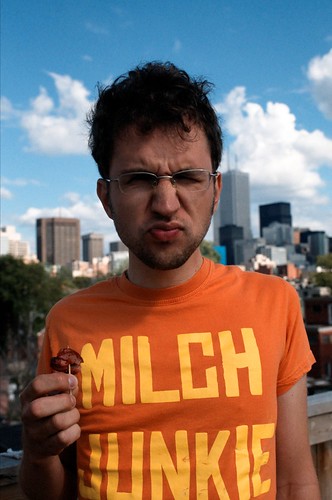I think that's why when I grew up, my family had the habit of heating our store-bought milk for breakfast so we could drink it warm. Most people are surprised by my habit of drinking warm milk since for them the natural state of milk is cold since it comes from the fridge.
Back then when my dad grew up, cow milk was a relatively natural product. Cows were fed mostly grass and hay while their dung – the natural byproduct of making cow's milk – was put back on the fields as a natural fertilizer. (Even better, when the cows grazed outside, their shit would just drop, stay where it landed and do good to the soil.)
In our days, things for the cows and the milk look quite different. The cows are fed less grass and more grains and soy, which is cheaper, but isn't good to their stomachs and causes sicknesses. Plant agriculture relies on cheap and more effective artificial fertilizer so the cow dung becomes waste. Since cows are now held in very small inside spaces the dung is very concentrated and becomes an environmentally damaging toxic, especially for small rivers and creeks into which some of the disposed dung might drizzle through the ground.
In our days the population of the earth is about 500 times higher than when agriculture was invented (now 7 billion, then 15 million). Planet earth, however, is still the same size as back then! In order to support this huge human population, agriculture and food need to become vastly more efficient. To make a liter of soy milk, I use about 100g of soy beans and about one-and-a-half liters of water. Besides the soy milk, I get about one cup of by-product (okara), which is a great food stuff to be used in a variety of dishes (or mixed with sugar or chocolate powder to be eaten like porridge). The dairy factory uses about 2kg of cow feed (often also soy beans) and 10 liters of water per liter of milk just to feed the lactating cows. That's already 20 times more plant material needed for the same amount of milk! Add to this all the food and water needed to raise the cow until milk-producing age plus all the chemicals and medicines needed for the cows. And with the cow milk, comes the toxic concentrated cow shit. While making better use of the plants and animals that we use for nutrition and industrial purposes, we don't want to poison the remaining ecosphere – plants and animals that we don't use (yet). So what are we to do?
To many people who are used to cow's milk, soy milk might seem like an artificial replacement for a natural product. But as we have seen, contemporary milk production in dairy factories is far from being anything like natural. The so called “factory farms” are certainly more factory than they are farm! Maybe you'll think that soy milk on the other hand, most certainly comes from a factory? While that's obviously true, we have to consider that soy milk production in a factory is not very different from how you would do it at home or, for that matter, how it is traditionally done for thousands of years in China. Additionally cow's milk has a lot of unhealthy saturated fats, while soy milk has more healthy unsaturated fats, including some of the essential fats that the human body cannot make itself and needs to get from food. Seen from that angle, isn't it just smart to be inspired by food production techniques from all the different human cultures when creating the diet of a future humanity of maybe 10 billion or more people?
Soy milk making is a simple process of soak, puree, boil, and filter. I do it at home several times per week and use a specialized pureeing-boiling machine for the two most messy steps.
When I drink my fresh-cooked soy milk in the morning, which is still hot from the machine, I feel a strong connection to the presumed natural life of my grand-parents who drank cow's milk still warm from the udder. So in a way, even though I don't live on a farm, and even though I am surrounded by a wagon-load of high-techy things, I still feel a connection to nature by making my own delicious, hot, and healthy milk in a way that respects the environment and is able to scale up to the other 7 billion (and counting) people on the planet.
Some interesting reads and sources:
- What are cows fed?
- How much does a cow eat?
- Information on factory farming is from the book Eating Animals (I like this quote: “Have a conversation with the people who produce your food. If you aren't allowed to see where your food comes from, you probably shouldn't be eating it.”)
- How to Make Soy Milk at Home (I use a simple metal strainer for filtering instead of a cheesecloth, because that's easier to clean. ;)
PS: I am going to add some really good photos here to relate past and present of my family heritage. It needs a while to find them!








